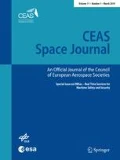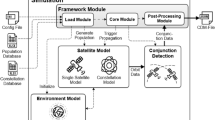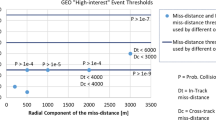Abstract
In the last two decades all major space agencies have established processes for operational conjunction analysis (CA) and collision avoidance (COLA). This work highlights the approaches of ESA, DLR, JAXA, NASA, CNES, and CSA. It is found that commercial satellite operators (Inmarsat, Intelsat, SES, and Eutelsat) do not primarily rely on the same sources of data as the major space agencies; however, a common operational process could be identified. Beside comparing the current operational state of the art, the models and methods used by the Combined Space Operations Center (CSpOC) to compute Conjunction Data Messages were studied. The space situational awareness (SSA) community still heavily depends on data provided by CSpOC; however, alternatives are maturing. Last but not least the operational state of the art is compared to theoretical developments of the SSA community. It is shown that while operational tools and processes meet the current needs, the gap is widening with respect to new high-fidelity methods available in literature (e.g., non-Gaussian uncertainty representations). This gap needs to be reduced for the systems to maintain compatibility to future requirements and expected perimeter changes, as for instance a heavily increased number of conjunction messages due to new sensor systems, such as the space fence radar and mega-constellation operations.

Source: [6]. Reprinted with permission

Source: [7]. Reprinted with permission

<link rid="credit">Source: [9]. Reprinted with permission

Source: [10]. Reprinted with permission

Source: [10]. Reprinted with permission

Source: [13]. Reprinted with permission

Source: [19]. © Government of Canada, reprinted with permission


Based on information provided at [26]

Source: [24]

Similar content being viewed by others
Notes
Prior July 2018, CSpOC was named Joint Space Operations Center (JSpOC).
The operated, to be protected, spacecraft is commonly called the “primary”, whereas the other satellite taking part in the collision is referred to as the “secondary”.
There is one exception: the “JAC”-tool developed by CNES is also used by NASA.
References
National Research Council. Continuing Kepler’s Quest: Assessing Air Force Space Command’s Astrodynamics Standards. National Academies Press, 2012
Liou, J.-C.: USA Space Debris Environment, Operations, and Research Updates. Committee on the Peaceful Uses of Outer Space. 29 January–9 February 2018, Vienna. https://web.archive.org/web/20190221155650030. https://ntrs.nasa.gov/archive/nasa/casi.ntrs.nasa.gov/20180001749.pdf. Accessed 21 Feb 2019
Okada, M., et al. Maximizing post mission disposal of mega constellations satellites reaching end of operational lifetime. In: ESA 7th European Conference on Space Debris, ESOC, Germany: (2017)
https://web.archive.org/web/20180531135145. https://gdmissionsystems.com/Articles/2016/04/07/news-release-4-7-2016-gd-completes-u-s-air-force-space-fence-radar-array-ground-structure. Accessed 31 May 2018
Flohrer, T., et al. Operational collision avoidance at ESOC. In: Deutscher Luft-und Raumfahrtkongress, Rostok, Germany: (2015)
Merz, K., et al. Current collision avoidance service by ESA’s Space Debris Office. In: Proceedings 7th European Conference on Space Debris, Darmstadt, Germany, 18–21 April 2017
Aida, S., Kirschner, M.: Collision risk assessment and operational experiences for LEO satellites at GSOC. In: Proceedings of the 22nd International Symposium on Space Flight Dynamics, Sao Jose dos Campos, Brazil: (2011)
Aida, S.: Conjunction risk assessment and avoidance maneuver planning tools. In: Proceedings of the 6th International Conference on Astrodynamics Tools and Techniques, Darmstadt, Germany: (2016)
Newman, L.K.: The NASA robotic conjunction assessment process: overview and operational experiences. Acta Astronaut. 66(7–8), 1253 (2010)
Moury, M., Newman, L.: Middle man concept for in-orbit collision risk mitigation: CAESAR and CARA examples. In: SpaceOps 2014 Conference, p. 1637: (2014)
Newman, L.K., et al.: Evolution and implementation of the NASA robotic conjunction assessment risk analysis concept of operations. In: Proceedings of the Advanced Maui Optical and Space Surveillance Technologies Conference, 9–12 Sept 2014 (2014)
Moury, M., Newman, L.: Middle man concept for in-orbit collision risk mitigation: CAESAR and CARA examples. In: SpaceOps Conference: 2014, p. 1637
Laporte, F., et al.: Collaborative work environment for operational conjunction assessment. In: Advanced Maui Optical and Space Surveillance Technologies Conference: (2015)
Matsuda, I., Hirose, C., Kudo, N.,: The JAXA conjunction assessment process. In: SpaceOps 2010 Conference, Alabama, US: (2010)
Hirose, C., et al.: Overview of JAXA space debris surveillance operations. In: Progress in Astronautics and Aeronautics, vol. 220, p. 293 (2007)
Hirose, C., et al.: Observation techniques made through The Kamisaibara radar. In: 61st International Astronautical Congress, IAC-10-A6, vol. 1 (2010)
Abe, J., et al.: Current status of conjunction assessment for JAXA satellites. In: JAXA Special Publication: Proceedings of the 6th Space Debris Workshop, p. 393 (2015)
Fathelrahman, B., Doyon, M., Viqar, A.: The Canadian Space Agency (CSA) Collision Risk Assessment and Mitigation System (CRAMS): Sharing the Development and the Operational Challenges
Abbasi, V., et al.: Advanced space situational awareness through automated conjunction risk analysis system (CRAMS) (2014)
Abbasi, V., et al.: Close encounters of an advanced kind: lessons learned and new approaches in collision risk assessment and mitigation. In: Proceedings 7th European Conference on Space Debris, Darmstadt, Germany, 18–21 April 2017 (2017)
Harvey, S.: The space catalog mission and conjunction analysis. Presentation (2014)
United States Airforce. Exhibit R-2, RDT&E Budget Item Justification. https://web.archive.org/web/20190314144838/https://www.globalsecurity.org/military/library/budget/fy2015/usaf-peds/0201184f_4_pb_2015.pdf. Accessed 14 Mar 2019
Kaya, D.A., et al.: AFSPC Astrodvnamic standards—the way of the future. https://web.archive.org/web/20190314144004/http://www.astrodynamicstandards.com/Resources/GetTRDoc.pdf. Accessed 14 Mar 2019
Department of the Air Force - AFSPC Standardized Astrodynamic Algorithm Library (SAAL): https://web.archive.org/web/20180608142553. https://www.astrodynamicstandards.org/media/1030/list_of_available_saal_dlls-15-sept-2017.pdf. Accessed 08 June 2018
Pachura, D., Hejduk, M.: Presentation: atmospheric model at JSpOC (2016). https://ntrs.nasa.gov/archive/nasa/casi.ntrs.nasa.gov/20160005044.pdf. Accessed 28 Apr 2018
DSoft Technology Company. Astrodynamic Standards. https://web.archive.org/web/20180428145524. http://www.astrodynamicstandards.com/standards. Accessed 28 Apr 2018
Homepage of Space Data Association. https://web.archive.org/web/20180328132742. http://www.space-data.org/sda/. Accessed 28 Mar 2018
Chow, T.: Space situational awareness sharing program: an SWF issue brief. In: Secure World Foundation, TR, Washington, DC (2011)
Molotov, I., et al.: Faint high orbit debris observations with ISON optical network. In: Advanced Maui Optical and Space Surveillance Technologies Conference, p. E21: (2009)
European Space Agency. SSA Programme overview. https://web.archive.org/web/20180328122350. http://www.esa.int/Our_Activities/Operations/Space_Situational_Awareness/SSA_Programme_overview. Accessed 28 Mar 2018
Foster, J.L., Estes, H.S.: A parametric analysis of orbital debris collision probability and maneuver rate for space vehicles. NASA JSC 25898 (1992)
Author information
Authors and Affiliations
Corresponding author
Additional information
Publisher’s Note
Springer Nature remains neutral with regard to jurisdictional claims in published maps and institutional affiliations.
Appendix: scientific state of the art
Rights and permissions
About this article
Cite this article
Schiemenz, F., Utzmann, J. & Kayal, H. Survey of the operational state of the art in conjunction analysis. CEAS Space J 11, 255–268 (2019). https://doi.org/10.1007/s12567-019-00242-2
Received:
Revised:
Accepted:
Published:
Issue Date:
DOI: https://doi.org/10.1007/s12567-019-00242-2






